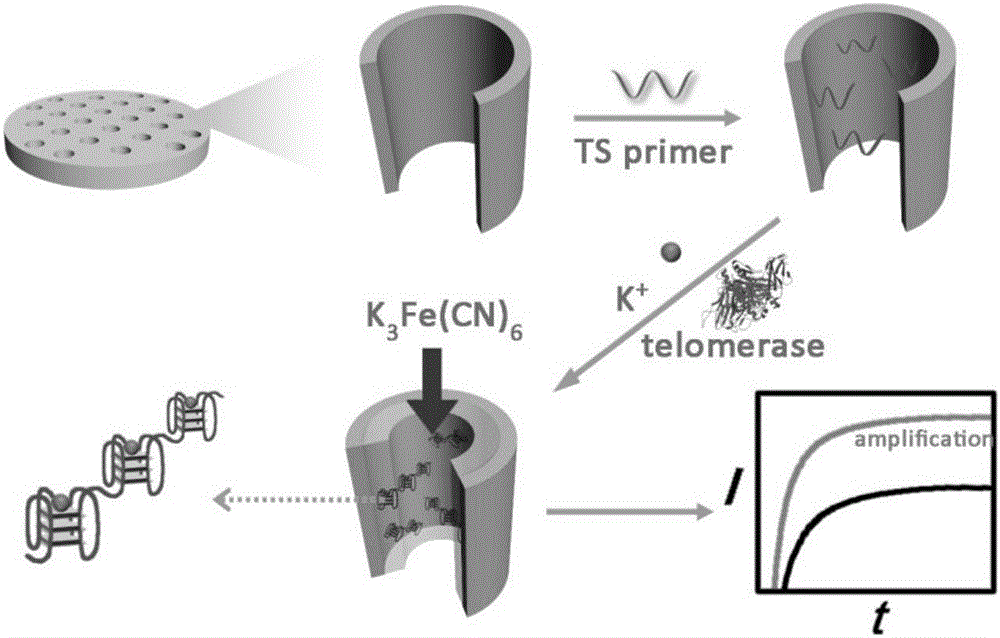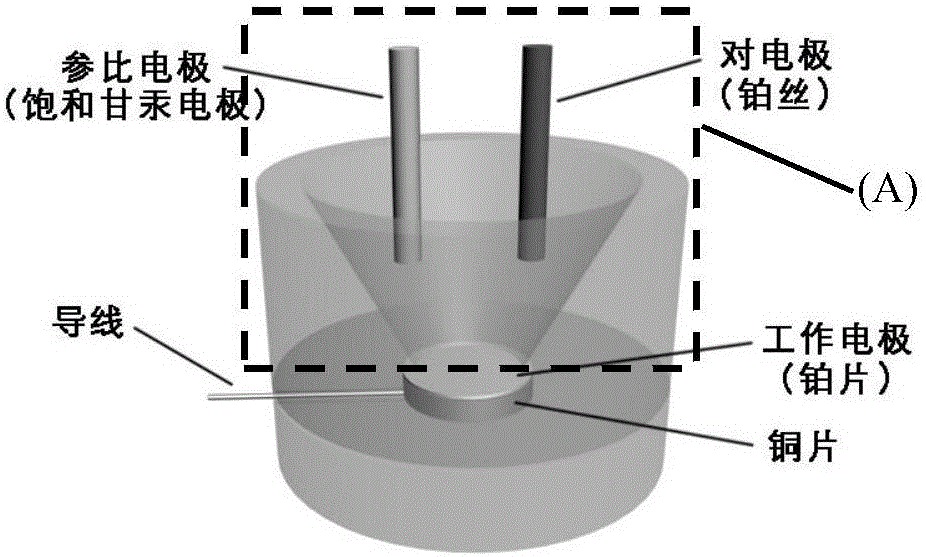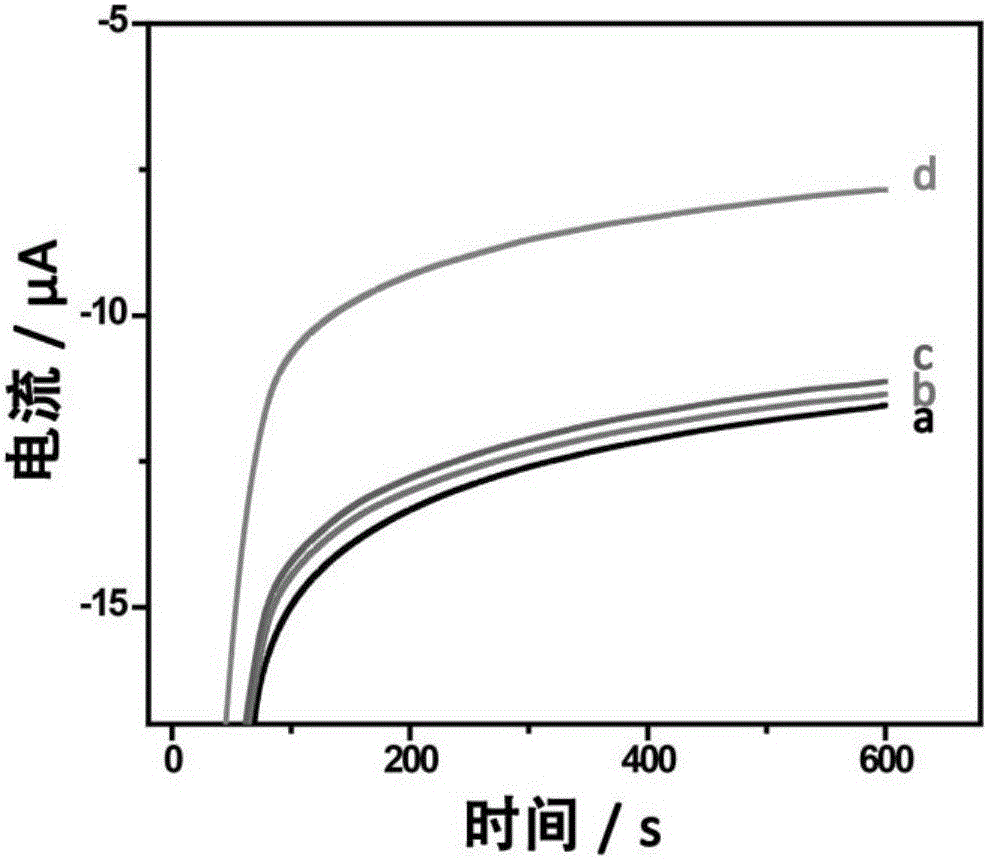Method for quantitatively detecting telomerase activity based on nano pore channel and electrochemical sensing
A nanopore and telomerase technology, applied in the field of biosensing, can solve the problems of poor sensitivity, expensive equipment and reagents, low sensitivity, etc., and achieve the effect of facilitating surface functionalization, mild reaction conditions, and stabilizing the overall structure
- Summary
- Abstract
- Description
- Claims
- Application Information
AI Technical Summary
Problems solved by technology
Method used
Image
Examples
Embodiment 1
[0046] see figure 1 , an analytical method for detecting telomerase activity in HeLa cells based on nanopores and electrochemical sensing, the detection steps are:
[0047] Step (1) cell culture and telomerase extraction: HeLa cells were inoculated in DMEM medium containing 10% fetal bovine serum, penicillin and streptomycin, and incubated in 5% CO 2 , cultured in a 37°C incubator. All cells were collected during exponential growth phase. Aliquot 1 million cells into 1.5 mL EP tubes, wash twice with ice-cold phosphate buffered saline (pH=7.4), and redisperse in 200 μL of ice-cold CHAPS lysis buffer (10 mM Tris-HCl, pH 7.5 ,1mMMgCl 2 , 1mMEGTA, 0.5% (w / v) CHAPS, 10% (v / v) glycerol, 0.1mMPMSF). Cells were incubated on ice for 30 minutes and then centrifuged at 12000 rpm for 20 minutes at 4°C. After centrifugation, carefully transfer the clarified lysate into a new EP tube, snap freeze and store in a -80°C freezer;
[0048] Step (2) Connect the telomerase primer modified wi...
Embodiment 2
[0054] see figure 1 , an analytical method for detecting telomerase activity in A549 cells, MCF-7 cells and MDA-MB-231 based on nanopores and electrochemical sensing, the detection steps are:
[0055] Step (1) cell culture and telomerase extraction: A549 cells, MCF-7 cells, and MDA-MB-231 cells were inoculated in DMEM medium containing 10% fetal bovine serum, penicillin and streptomycin, and were incubated at 5 %CO 2 , cultured in a 37°C incubator. All cells were collected during exponential growth phase. Aliquot 1 million cells into 1.5 mL EP tubes, wash twice with ice-cold phosphate buffered saline (pH=7.4), and redisperse in 200 μL of ice-cold CHAPS lysis buffer (10 mM Tris-HCl, pH 7.5 ,1mMMgCl 2 , 1mMEGTA, 0.5% (w / v) CHAPS, 10% (v / v) glycerol, 0.1mMPMSF). Cells were incubated on ice for 30 minutes and then centrifuged at 12000 rpm for 20 minutes at 4°C. After centrifugation, carefully transfer the clarified lysate into a new EP tube, snap freeze and store in a -80°C ...
Embodiment 3
[0061] see figure 1 , an analytical method for detecting telomerase activity in A549 cells based on nanopores and electrochemical sensing, the detection steps are:
[0062] Step (1) cell culture and telomerase extraction: A549 cells, MCF-7 cells, and MDA-MB-231 cells were inoculated in DMEM medium containing 10% fetal bovine serum, penicillin and streptomycin, and were incubated at 5 %CO 2 , cultured in a 37°C incubator. All cells were collected during exponential growth phase. Aliquot 1 million cells into 1.5 mL EP tubes, wash twice with ice-cold phosphate buffered saline (pH=7.4), and redisperse in 200 μL of ice-cold CHAPS lysis buffer (10 mM Tris-HCl, pH 7.5 ,1mMMgCl 2 , 1mMEGTA, 0.5% (w / v) CHAPS, 10% (v / v) glycerol, 0.1mMPMSF). Cells were incubated on ice for 30 minutes and then centrifuged at 12000 rpm for 20 minutes at 4°C. After centrifugation, the clarified lysate was carefully transferred to a new EP tube, snap-frozen and stored in a -80 °C freezer. And prepare...
PUM
| Property | Measurement | Unit |
|---|---|---|
| pore size | aaaaa | aaaaa |
Abstract
Description
Claims
Application Information
 Login to View More
Login to View More - R&D
- Intellectual Property
- Life Sciences
- Materials
- Tech Scout
- Unparalleled Data Quality
- Higher Quality Content
- 60% Fewer Hallucinations
Browse by: Latest US Patents, China's latest patents, Technical Efficacy Thesaurus, Application Domain, Technology Topic, Popular Technical Reports.
© 2025 PatSnap. All rights reserved.Legal|Privacy policy|Modern Slavery Act Transparency Statement|Sitemap|About US| Contact US: help@patsnap.com



